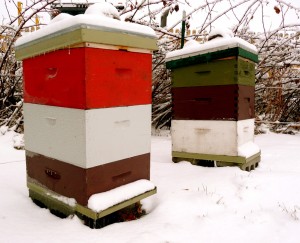Live from the Hive: February 2014
“Weather and Pollen Stores, an Intricate Dance” by Annie Watson
Even as we face the coldest days of the winter, the queen begins laying eggs for the young that will replace those lost over the winter. If her family collected a lot of pollen in the fall and has abundant honey stored, she will start earlier, and as the weather warms, there will be more new bees and the colony will go into spring stronger. In colonies with a lack of pollen, the queen delays her laying until fresh pollen is available in early spring. Those colonies emerge from winter with reduced populations.
The gift of the queen’s laying, along with her timing, are in an intricate dance with the weather and pollen stores, all part of the miracle of the bees’ connection with nature and communication with each other to work together for the survival of the colony.


